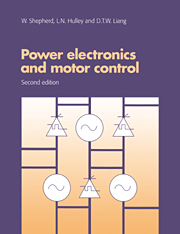Book contents
- Frontmatter
- Contents
- Preface to first edition
- Preface to second edition
- List of principal symbols
- 1 Power switching theory
- 2 Switching devices and control electrode requirements
- 3 System realisation
- 4 Adjustable speed drives
- 5 D.c. motor control using a d.c. chopper
- 6 Controlled bridge rectifiers with d.c. motor load
- 7 Three-phase naturally commutated bridge circuit as a rectifier or inverter
- 8 Single-phase voltage controllers
- 9 Three-phase induction motor with constant frequency supply
- 10 Induction motor slip-energy recovery
- 11 Induction motor speed control by the use of adjustable voltage, adjustable frequency step-wave inverters
- 12 Induction motor speed control by the use of adjustable frequency PWM inverters
- Appendix General expressions for Fourier series
- Answers to problems
- References and bibliography
- Index
4 - Adjustable speed drives
Published online by Cambridge University Press: 05 June 2012
- Frontmatter
- Contents
- Preface to first edition
- Preface to second edition
- List of principal symbols
- 1 Power switching theory
- 2 Switching devices and control electrode requirements
- 3 System realisation
- 4 Adjustable speed drives
- 5 D.c. motor control using a d.c. chopper
- 6 Controlled bridge rectifiers with d.c. motor load
- 7 Three-phase naturally commutated bridge circuit as a rectifier or inverter
- 8 Single-phase voltage controllers
- 9 Three-phase induction motor with constant frequency supply
- 10 Induction motor slip-energy recovery
- 11 Induction motor speed control by the use of adjustable voltage, adjustable frequency step-wave inverters
- 12 Induction motor speed control by the use of adjustable frequency PWM inverters
- Appendix General expressions for Fourier series
- Answers to problems
- References and bibliography
- Index
Summary
BASIC ELEMENTS OF A DRIVE
A rotational mechanical load in which any one of a wide range of operating speeds may be required is often called an ‘infinitely variable speed drive’ or, more modestly, a ‘variable speed drive’ or ‘adjustable speed drive’. Suitable operating characteristics to provide a given range of load torques TL and speeds N might be provided by a pneumatic or hydraulic drive as well as by several forms of electrical variable speed drive. The basic components of such a drive, Fig. 4.1, are the motor or actuator that delivers torque to the load and controls its speed and the power controller that delivers power to the motor in a suitable form. In this book only those drives in which the drive motor is an electric motor are considered.
The output power developed by an electric motor is proportional to the product of the shaft torque and the shaft rotational speed. The value of the developed torque usually varies automatically to satisfy the demand of the load torque plus any torque associated with friction and windage. Increase of the shaft power due to increase of load torque is usually supplied by automatic increase of the supply current demanded by the motor. Any significant change in motor speed, however, must be obtained in a controlled manner by making some adjustment to the motor or to its electrical supply.
- Type
- Chapter
- Information
- Power Electronics and Motor Control , pp. 121 - 151Publisher: Cambridge University PressPrint publication year: 1996

